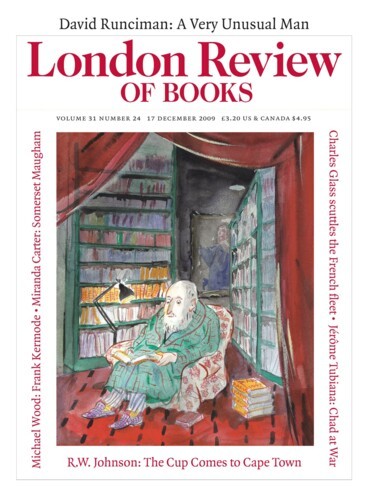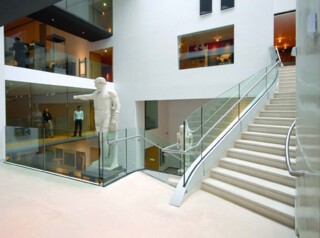C.R. Cockerell’s Ashmolean Museum of 1845 has a pedimented central bay with projecting wings. The architectural detail – in two colours of stone, used very prettily – draws on his archaeological work in Greece. It is a fine thing: less dour than Smirke’s earlier British Museum, less grandiloquent and more thought through than Basevi’s later Fitzwilliam Museum. In the planning of the new works that have doubled the museum’s display space Cockerell’s building has been treated respectfully; nothing of what the £61 million was spent on shows until, as you approach the main entrance, you realise that there is a new, glass, inner wall. The majestic doors can now stand open in any weather.
Cockerell’s Ashmolean was built to a recognisable 19th-century pattern. The extension by Rick Mather Architects is an example of an equally recognisable early 21st-century style that uses pale stone and pale wood for floors, glass for balustrades, stainless steel for rails and trim. It is a way of building that provides a neutral environment – pyrotechnics are usually reserved for the circulation spaces. In the new part of the Ashmolean most of the architectural drama is concentrated in the well that runs from roof to basement and brings at least a glimpse of daylight to all the new gallery floors. You are drawn towards this central space as you enter the building by the brightness you glimpse beyond the dimness of the entrance hall. (The same move from dim to bright is effected in the British Museum when you head for the Great Court.) The stairs are a tour de force; they swing up the wall of the well in curved flights that are counterpointed by the line of glass balustrades and steel handrails. The stairs are what has most often been chosen to illustrate reviews of the new work.
The new building and the old treat the collection in different ways. Now that many things previously in storage are on display the variety of material the Ashmolean holds – the fact that it is a collection of collections – is even more apparent. To get a notion of the range think of the London museums you would have to visit to cover the same territory: the National Gallery to match the Italian pictures; the Tate for the Pre-Raphaelites, Pissarros and Sickerts; the British Museum for the old master drawings and Greek, Roman, Chinese, Japanese and Egyptian material. Only the V&A could match the textiles, glass and ceramics. And then there are the musical instruments, and the foundation collection of material assembled in the 17th century by the Tradescants, which covers ethnography and natural history.
Some parts of the museum are unchanged and will doubtless remain so. Most of the paintings occupy the rooms in the old building that have always housed them. Some have been spruced up – there are walls of new crimson damask – but the galleries, like the original severely elegant staircase and the long corridor of Greek and Roman sculpture on the ground floor, still serve their purpose well. The traditional presentation of a collection of pictures in a procession of rooms in which school succeeds school and century follows century is hard to improve on – thematic groupings by subject matter, say, or influence, haven’t had a good press.
Elsewhere the extravagant range of the collections underwrites a different approach. It is announced as ‘a new display strategy’:
Crossing Cultures Crossing Time (CCCT) is an approach based on the idea that civilisations that have shaped our modern societies developed as part of an interrelated world culture, rather than in isolation. It assumes, too, that every object has a story to tell, but these stories can best be uncovered by making appropriate comparisons and connections, tracing the journey of ideas and influences through the centuries and across continents.
Just how well the idea works will become apparent when the labelling and the arrangement of cases are complete. And as CCCT connections are well made in words, in illustrated books and television programmes it is worth considering less intellectually challenging ways of relating to museums. In the presence of real things one’s questions tend to be less abstract. Knowing that the death mask before one is only a step away from the flesh of the long dead man, that the toy is the very one an Egyptian child played with, are experiences not available from the printed page. Sometimes you even need to do more than look. To make a final judgment on a Chinese pot, I’m told, you must hold it. A promise that goes with the expansion of space at the Ashmolean is more contact with objects.
Public institutions have never been under so much pressure to show that they are being run for all of us. Emphasising their educational function is part of that. Seeing a party of schoolchildren in the old part of the museum happily notetaking among Egyptian things still close packed in crowded cases was a reminder that, while a new environment may draw you in, it is the things themselves that keep you coming back.
Acquisitiveness, curiosity, the pursuit of knowledge, aesthetic pleasure: these are enough to explain why some things were collected. They don’t always explain why we want to go and look at them. Objects collected as archaeological evidence, for example, may take on a significance that has little to do with hard-won facts about their origins. In one case of Cycladic figures in the Ashmolean there is a quotation from Henry Moore, who much admired their bleached simplicity and purity of form. In the same case there is a replica of one of them that has been given the touches of colour they probably all had when they were new. Moore might have been disappointed.
Museums feed the eye and then the mind. We flock in, and, like hens in a farmyard, peck at this exhibit and then that – attracted by something that glitters or is familiar or looks delicious. We range freely and our styles of foraging vary. The heterogeneousness of the collection allows for all kinds of response. Delight in the prettiness of a Chinese coat; amazement at skill in ceramics, metal, wood or textiles; the actuation of whatever appetite it is that persuades us to respond to what makes a painting great (and then, at another time to decide that the appetite was false and that it is not great at all).
The new Ashmolean is a wonderful thing. It will let more of us – scholars, aesthetes, children, pensioners – see more things. Last Friday the pensioners, some needing canes and wheelchairs, were in evidence, and the supply of lifts was proving inadequate – the only practical failing I noticed. The fact that many of them were heading for that other regular feature of museum renovation – the rooftop restaurant with view – made it more obvious.
Send Letters To:
The Editor
London Review of Books,
28 Little Russell Street
London, WC1A 2HN
letters@lrb.co.uk
Please include name, address, and a telephone number.


